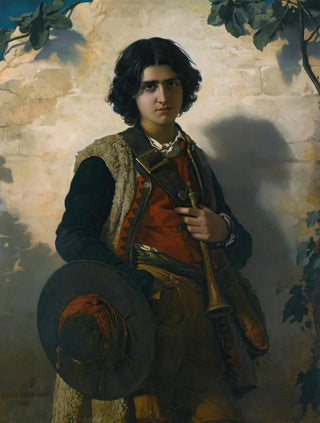Art print | The Italian Fife - Henri Lehmann


View from behind

Frame (optional)
The canvas "The Italian Fife Player" by Henri Lehmann is a work that transports the viewer into a vibrant world of colors and sensations. Painted in the heart of the 19th century, this piece showcases the undeniable talent of the artist, while offering a fascinating glimpse into the culture and traditions of the time. The painting, with its captivating central subject—a young musician in full performance—evokes a silent melody that resonates in the minds of those who observe it. Through this art print, the very essence of the original work is preserved, allowing each person to immerse themselves in the enchanting atmosphere that Lehmann masterfully created.
Style and uniqueness of the work
Henri Lehmann's style is distinguished by a bold use of color and an exceptional mastery of light. In "The Italian Fife Player," the contrast between shadows and highlights enhances the vibrancy of the hues, making the main character almost alive. The composition is carefully orchestrated, with each element contributing to the overall dynamism. The young musician, dressed in traditional clothing, is depicted in an expressive posture that captures attention and evokes emotion. Lehmann manages to transcend the simple portrait by offering a lively scene where movement and music seem to intertwine. This singularity makes his work a true testament to the artistic passion of the 19th century.
The artist and his influence
Henri Lehmann, a French painter of German origin, made a name for himself in the art world thanks to his unique style and his ability to capture the essence of his subjects. Trained at the École des beaux-arts in Paris, he was influenced by the great masters of his era, while developing a personal approach that is entirely his own. His work is marked by a particular sensitivity to the beauty of gestures and human emotions. Lehmann succeeded in establishing himself as a preferred portraitist, but also as a visual storyteller, capable of narrating stories through his paintings. His contribution to French art of the 19th century is undeniable, and "The Italian Fife Player" is a perfect example, illustrating both his talent and his commitment to

Matte finish

View from behind

Frame (optional)
The canvas "The Italian Fife Player" by Henri Lehmann is a work that transports the viewer into a vibrant world of colors and sensations. Painted in the heart of the 19th century, this piece showcases the undeniable talent of the artist, while offering a fascinating glimpse into the culture and traditions of the time. The painting, with its captivating central subject—a young musician in full performance—evokes a silent melody that resonates in the minds of those who observe it. Through this art print, the very essence of the original work is preserved, allowing each person to immerse themselves in the enchanting atmosphere that Lehmann masterfully created.
Style and uniqueness of the work
Henri Lehmann's style is distinguished by a bold use of color and an exceptional mastery of light. In "The Italian Fife Player," the contrast between shadows and highlights enhances the vibrancy of the hues, making the main character almost alive. The composition is carefully orchestrated, with each element contributing to the overall dynamism. The young musician, dressed in traditional clothing, is depicted in an expressive posture that captures attention and evokes emotion. Lehmann manages to transcend the simple portrait by offering a lively scene where movement and music seem to intertwine. This singularity makes his work a true testament to the artistic passion of the 19th century.
The artist and his influence
Henri Lehmann, a French painter of German origin, made a name for himself in the art world thanks to his unique style and his ability to capture the essence of his subjects. Trained at the École des beaux-arts in Paris, he was influenced by the great masters of his era, while developing a personal approach that is entirely his own. His work is marked by a particular sensitivity to the beauty of gestures and human emotions. Lehmann succeeded in establishing himself as a preferred portraitist, but also as a visual storyteller, capable of narrating stories through his paintings. His contribution to French art of the 19th century is undeniable, and "The Italian Fife Player" is a perfect example, illustrating both his talent and his commitment to






